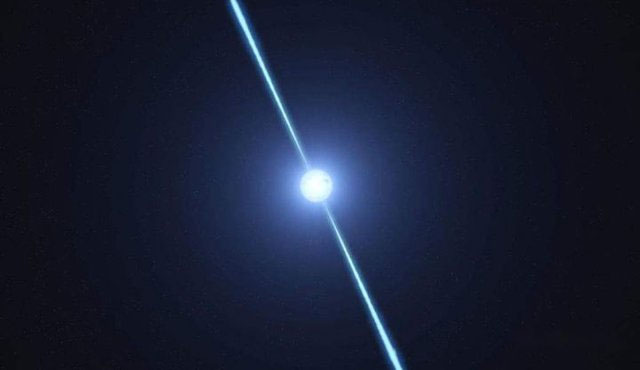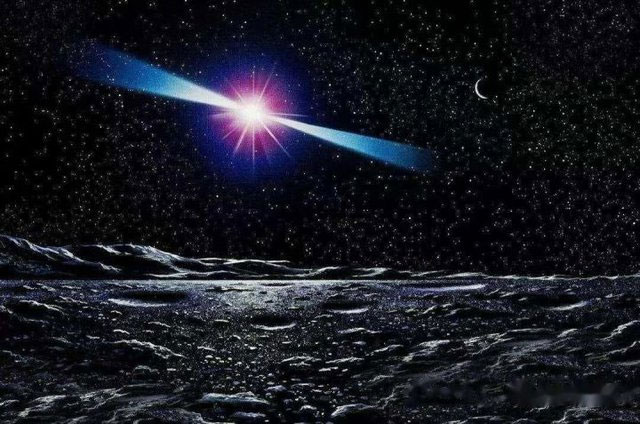Why can a spoonful of matter in a neutron star weigh up to 100 million tons?
The mass per cubic centimeter can amount to more than 100 million tons, and a tablespoon of matter weighs as much as a mountain on Earth. Neutron stars are undoubtedly one of the densest known objects in the universe.
Neutron stars are one of the possible end points in the evolution of some massive stars. Initially, neutron stars existed only in theory, but in 1967, scientists discovered the first pulsar and proved the existence of neutron stars.

Neutron stars are formed in supernova explosions and are usually symmetrical. So a lot of neutron stars never leave the explosion region where they formed. However, in some cases, the asymmetry in the explosion creates a repulsive force on the neutron stars and moves them away from the remnants of the explosion.
This discovery was one of the four most important discoveries in astronomy in the 1960s. Because pulses emit radio signals so regularly, people once thought it was a signal from a civilization. alien, but eventually science proved that it is indeed a neutron star rotating at high speed.
The reason why the density of a neutron star is so great is that it is formed by the collapse of a part of the star's core under the influence of gravity, and a large amount of matter is concentrated in a large range. microspace is extremely small, so the mass of a neutron star is extremely large while its radius is very small, usually around 10 to 20 km.
The mass of the Earth is about 60 trillion tons and the radius is 6,378km, if the Earth reached the end of its life cycle and was compressed into a neutron star, its radius would be only 22 meters.

Pulsed stars are neutron stars that rotate rapidly and emit intense radiation, while magnetic stars are remnants of stars with strong magnetic fields. All types of neutron stars form when high-mass stars end their lives and run out of fuel for nuclear fusion, whereby the original star can no longer fend off its own collapse. gravity.
How can such a large object be compressed down to a much smaller size than it was originally? To understand it, we have to start from the microscopic structure of matter.
Ordinary matter in the universe is made of atoms, but an atom is not a solid sphere. The interior of the atom also contains the same indefinite voids as our Solar System. The sun makes up 99% of the total matter in the entire Solar System, and the nucleus of an atom also makes up 99% of the atomic mass, in which electrons often move freely in this extremely large space, creating into a hard shell called an electron cloud.
If enough pressure is applied, this shell will break open and electrons will be forced close to the nucleus or even fall into it. At this point, the structure of the atom will be destroyed so that a large amount of matter can be compressed into a very small volume.

Magnetic stars are a type of neutron star with a magnetic field as strong as 10 to 11 tesla, about 2,500,000 billion times larger than Earth's magnetic field. For comparison, the magnetic field around the dipole superconducting magnets of the LHC is only between 0.54 and 8.3 tesla. The existence of stars was first proposed by two astronomers Robert Duncan of the US and Chrisopher Thompson of Canada in the 1980s.
In theory, the density of a neutron star is second only to that of a black hole, because scientists believe that the volume of the singularity enclosed within the horizon of the black hole is 0, which means that the density of the singularity is zero. Black holes are infinite. However, humans know very little about black holes, what is inside a black hole is still unknown to science and it is likely beyond our current knowledge. Therefore, existing theories about the interior of a black hole are all hypothetical and possibly incorrect.
In addition to their high density, neutron stars are also divided into two special categories, one called pulsars and the other called magneto or magnetic stars.
The magnetic field of a magnet is thousands of times stronger than that of an ordinary neutron star and hundreds of billions of times stronger than the magnetic field of the Earth. Pulsars are one of the fastest rotating planets in the universe. Their rotational speeds at the equator are often up to tens of thousands of kilometers per second, and the escape velocity on the surface is also as great as tens of thousands or even hundreds of thousands of kilometers per second.
In some works of science fiction, they are even used directly as weapons by advanced alien civilizations. If two neutron stars collide, it will also trigger a powerful gamma-ray burst, releasing energy for a short period of time equivalent to the total energy released by the Sun during its lifetime. .
- The original gold smelter in the universe
- The neutron star collision is 520 million light-years from Earth
- Detecting unprecedented neutron stars, challenging the physical limit
- Unexpectedly, the most remote, lonely neutron star in the universe
- All humans weighing how many kg?
- The discovery of the neutron star collision is 'breakthrough' of 2017
- Video: The crazy dance of Vela neutron stars
- Neutron stars have a magnetic field 1,000 times stronger than normal
- Quark matter in neutron stars
- What is a Neutron Star?
- Discover the source of gravitational waves from neutron stars
- The 'eat' star companion in binary
 Van Allen's belt and evidence that the Apollo 11 mission to the Moon was myth
Van Allen's belt and evidence that the Apollo 11 mission to the Moon was myth The levels of civilization in the universe (Kardashev scale)
The levels of civilization in the universe (Kardashev scale) Today Mars, the sun and the Earth are aligned
Today Mars, the sun and the Earth are aligned The Amazon owner announced a secret plan to build a space base for thousands of people
The Amazon owner announced a secret plan to build a space base for thousands of people